Context: Recently, the Ministry of coal has set a target to gasify 100 million tonnes of coal by FY 2030 in line with its energy transition plans.
| Probable Question:
Q. What are the reasons for pursuing coal gasification, the challenges associated with its implementation, and potential strategies to overcome these challenges and move forward with the technology? |
Highlight
- Aim: To meet the future energy needs of the country while stimulating other sectors.
- The ministry is considering a comprehensive scheme, with an outlay of ₹6,000 crore, to promote coal and lignite gasification projects for both public sector undertakings (PSUs) and the private sector.
- PPP model for Gasification: Selection of PSUs and private sector companies for budgetary support for gasification projects will be done through a tariff-based bidding process.
National Coal Gasification Mission
- The Indian government aims for 100 million ton (MT) coal gasification by 2030, with investments worth over Rs. 4 trillion.
- In order to encourage the use of clean sources of fuel, the government has provided a concession of 20% on revenue share under commercial coal block auctions.
- CIL has also planned to set up at least 3 gasification plants (besides Dankuni) on BOO (Build-own-operate) basis through global tendering and has signed an MoU with GAIL for marketing synthetic natural gas.
|
Need for Coal Gasification: Abundant indigenous Coal Source

- Transition: India has huge reserves of coal, it would be beneficial for India if it finds a sustainable way of using these reserves as the world including India is gradually transitioning away from coal toward cleaner fuels in the wake of climate change.
- Energy Security: The use of domestic coal reserves becomes even more important, especially when India does not have other sources of fuel – crude oil and natural gas, 82% and 45% of the requirement of those fuels is met through imports. This exposes India to the vagaries of price volatility and supply insecurity.
- Sustainable usage of coal: India will continue to depend on coal for its future energy needs at least till 2050 as per several reports. Since coal has to be used for coming 2 to 3 decades, there is an urgent need to make use of coal as green as possible.
About Coal Gasification:
- Process: Coal gasification is a thermo-chemical procedure wherein the pressure and heat of the gasifier disintegrate coal into its chemical components.
- Constituents: The resulting “syngas” is mostly carbon monoxide (CO) and hydrogen, with some other gaseous substances such Hydrogen Sulphide and Carbon dioxide.
- Cleaner Alternative: Coal gasification is said to be more efficient than traditional coal burning since it can use the gases two times:
- Primary use: Coal Gases are first purified of contaminants before being fired inside a turbine to produce energy.
- Secondary use: The gas turbine exhaust heat can be then collected and used to produce steam for a steam turbine-generator.
- Efficiency: Coal gasification processing facility using this dual method can possibly attain an efficiency of 50% or higher, compared to the customary coal power plant, which is typically just above 30%.

Image Source: White Paper on Coal Gasification
Methods of Coal Gasification
- In-situ method: Here oxygen is infused into the seam together with water and ignited at high temperatures, causing coal to partly oxidize into hydrogen, CO, carbon dioxide (CO2), methane (CH4), and hydrogen sulfide (H2S).
- Ex-situ reactors: They are designed to simulate the gasification process above the ground’s surface.
- Sulphur in coal is transformed to H2S and trace volumes of carbonyl sulphide((COS) during the gasification process .
Types of Gasifiers
- Fixed Bed Gasifiers: Ithas a solids stream that is independent of the gas flow, needs little pretreatment of the feed coal, and has a high thermal efficiency.
- Fluidized Bed Gasifiers: It has uniform particulate blending, uniform thermal gradients, a high char recycling percentage, and a low capital cost.
- Entrained Flow Gasifiers: It can handle almost any feed, and the syngas it produces is free of oils and tars.
Advantages of Coal Gasification:
- Industrial Application of Coal Gas
- Raw Source of Energy: Syngas can be used to generate power, in energy-efficient fuel cell technology, or as chemical “building components” for industrial applications.
- Source of Hydrogen economy: The hydrogen can also be extracted and used to power a hydrogen economy.
- Automobile Fuel: Coal gas can also be transformed into a transportation fuel to be used in automobiles as a replacement for gasoline.
- Steel Industry: Syngas (CO and H2) are essential reducing agents for steel production and are regarded as an environmentally friendly technique of steel production because they reduce the import of furnace oil.
- Generating Electricity: The synthesis gas can be used in an Integrated Gasification Combined Cycle (IGCC) system to generate electricity in an efficient and environmentally friendly manner.
- Miscellaneous Product: It could be used to generate a range of products using clean coal innovations such as hydrogen, methanol, and fertilisers via coal gasification. Carbon fibres and plastic composites made from coal power plant ash/residue.
- AtmaNirbhar Bharat: The syngas produced by coal gasification can be used to generate urea and a variety of products such as methanol, Dimethyl ether (DME), and olefins, allowing India to minimize imports and become self-sufficient.
- Pharmaceutical Industry: India has ambitious plans to produce active pharmaceutical ingredients (API) domestically rather than importing them from China.
- There is a high potential of Syngas in making APIs, as well as methanol as a solvent.
- Cleaner and Environmental Friendly: There is no scrubber sludge produced by coal gasification plants.
- The majority of the wash water is reprocessed, and residual waste waters from gasification plants can be treated effectively.
- As a result, coal gasification is regarded as a cleaner coal technology when compared to coal combustion.
- Achieving Paris Commitment: India announced environmental targets as its Nationally Determined Contribution (NDC) under the Paris Agreement in 2016 and revised targets in COP 26 at Glasgow.
- Coal gasification aids in the decrease of emission levels and the advancement of non-fossil fuel-based energy resources.
Challenges in Coal Gasification:
- Quality of Coal: High ash content of Indian coal is a crucial barrier in the development of suitable technology.
- Induced Subsidence: The void created by deep mining during coal gasification process may cause significant deformation both in the remaining coal and surrounding rocks. Heating, quenching, water flux and potential roof and wall collapse may seriously compromise the integrity of the cavity leading to a subsidence.
- Occupational hazard: Coal Gasification process cannot be controlled to the same extent as surface gasifiers which poses the risk on account of high temperature and pressure in the cavity which furthers the risk for the workers.
- Environmental Factors: According to some studies, coal gasification actually generates more CO2 than a conventional coal power station.
- Groundwater Contamination: While the nation already faces a water scarcity, coal gasification is one of the more water-intensive energy generation methods.
- Economy of Project: It is an inherently ‘unsteady’ state process and both the flow rate and the heating value of the product gas will vary over time.
- Changes in the quantity and quality of gas produced will have a significant impact on the economics of the project.
- Technological Concern: Lack of availability of proven gasification technology suitable for Indian poor-quality Coal
Way Forward:
- ‘Dedicated, closed Coal Mines’ to be earmarked for Coal Gasification Projects (to be awarded through Auction Linkage) for better Coal Quality consistency , sustained Supply & closer Mining & Transportation Cost control.
- Viability gap funding, Infrastructure status: Financial Incentives from Govt to support very high Capex of Gasification Projects needed to improve Viability of ‘Energy Security’ (Clean) Projects.
- Level playing field: Exemption from currently applicable Cess / Duties on Coal Feedstock prices to be provided for Environment – friendly Coal Gasification Projects due to its Clean Technology adaptation.
- ‘National Policy on Coal Gasification & Liquefaction’ should be urgently formulated and promulgated for faster and smooth implementation of Coal Gasification based Projects.
- Schemes for ‘Blending Methanol, DME with Gasoline & LPG’ respectively to be implemented at the earliest, also requiring policy framework for all by products of coal gasification.
News Source: Livemint
![]() 15 Jul 2023
15 Jul 2023


